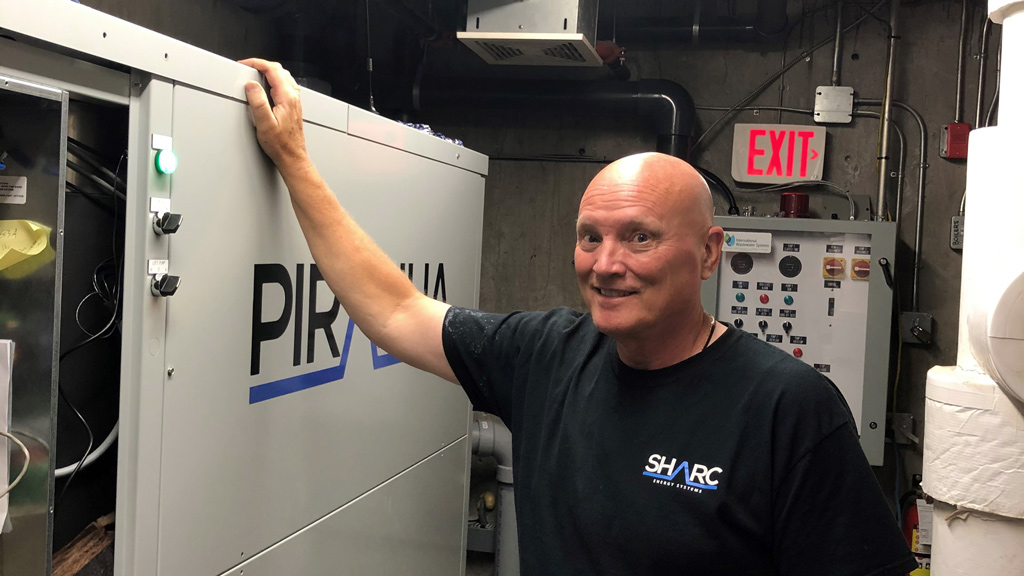Wastewater heat recovery systems are often linked to larger treatment facilities or energy districts, but SHARC Energy Systems, located and manufactured in suburban Port Coquitlam, B.C., has developed the PIRANHA T10, a small scale unit that can be installed in multiple urban residential buildings (MURBs) as small as five to 10 units as well as single ICI sector buildings.
The units work on the same principle longed-used in green buildings where heat is captured before spent air in vented out of the building. Only instead of occurring at the top of the building, the system works at the bottom, capturing heat from spent wastewater. The units can be used in a wide range of applications, co-founder Lynn Mueller said.
“Anywhere there is a lot of hot water used,” said Mueller, whose company has installed 25 of the SHARC large-scale units and 20 PIRANHA units in Canada, the U.S. and abroad.
The PIRANHA unit returns wastewater heat to a building to be used to reheat new hot water for in-house use. It becomes an endless cycle, said Mueller.
Units have been installed in MURBs in Vancouver and Burnaby, commercial outlets such as the Lake Louise Inn’s laundry, where energy for hot water was reduced 45 per cent, and recently Richmond laundry WashOut, a commercial laundry service with strong environmental concerns, signed a rebate agreement with FortisBC for the installation of a unit. WashOut is projected to save over 2,100 gigajoules per year of natural gas, saving 105 tonnes of greenhouse gas (GHG) emissions annually.
WashOut’s installation, which can occur over the next 18 months, is a retrofit but the units can also be installed in new construction. The FortisBC rebate program provides incentive for companies and residential complexes to reduce their energy consumption and, in turn, the associated carbon emissions, said Mueller.
“WashOut couldn’t be more excited to be a business leader taking the initiative to reduce our carbon footprint as the first laundry in Vancouver to install a PIRANHA system, significantly reducing our GHG emissions and saving on energy costs,” said Mike Freides, founder of WashOut, in a news release. “SHARC Energy and FortisBC made it easy to take this step for the climate.”
An Adera 60-unit North Vancouver building, which has a PIRANHA installed, has been a case study for the company and was used at an example last year at the U.S. Incubatenergy Labs and Ameren Accelerator Demo Day, which was attended by leading U.S. electric power sector leaders. The case study showed significant savings offsetting the GHG from the gas-boiler system in buildings.
Mueller said he was casting around for new venture when he hit upon the need to recapture heat from wastewater in buildings.
“There had to be a way to get it back,” he said.
Mueller, who came from a career in refrigeration and headed an international company manufacturing geothermal heat pumps, joined with co-founder Daryle Anderson, president of CIR Mechanical and who has 25 years experience in mechanical contracting and installations on projects, to found SHARC in 2010.
Former B.C. premier Mike Harcourt was put onto the board of directors.
Mueller said the PIRANHA equipment takes up a small footprint when recapturing that heat.
“About the size of a parking space,” he said. The system utilizes a holding tank capturing half the building’s volume and then uses a heat pump to draw off and concentrates heat, returning it to the building.
Anderson said while this concept is new to North America, there are thousands of similar units installed throughout Europe. He said installing these smaller units is no different than installing a boiler system within a MURB.
Anderson said his mechanical contracting firm CIR does not have exclusive installation rights but has installed most of the units and offers its expertise. But, he said, the firm is willing to work with other installers and SHARC can also offer support.
The cost of the PIRANHA is approximately $100,000 depending on unit size and Mueller estimates the units can return the investment as early as five years depending upon the application. The units have a 25 to 40 year lifespan, but do require regular maintenance to be effective.
“We are building the units incredibly robust and the whole function is to provide a long-term solution to climate change and provide something that is quality both inside and out,” he said.
Metro Vancouver’s Paul Kadota, program manager for utility research and innovation in the Liquid Waste Services department, said he is aware of the SHARC systems but it is policy to not comment on equipment unless it is used by Metro Vancouver.
Kadota said he believes in the concept of heat recovery from building wastewater and its ability to reduce GHGs.
“If we are going to achieve carbon neutrality by 2050, then this is another brilliant idea,” he said, adding while recovering wastewater heat can be integrated into an existing structure, the maximum benefit is gained in new and larger building designs that are geared towards achieving carbon neutrality.
SHARC’s larger systems are also being used in Canada and the U.S. Earlier this year, Colorado’s National Western Center, an innovations hub under construction in Denver to pioneer food and agricultural research, announced it will use SHARC’s technology to recover the heat in wastewater. The National Western Center is pioneering the largest scale wastewater district-energy innovation in North America to date. The National Western Center will rely on two SHARC wastewater recovery systems placed in the heart of its 3.8-megawatt district energy system creating a low-carbon campus.











Recent Comments
comments for this post are closed